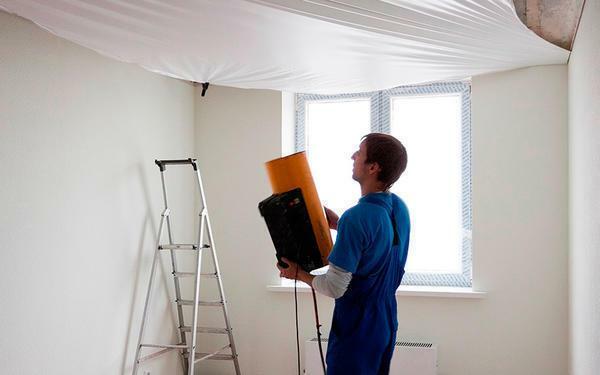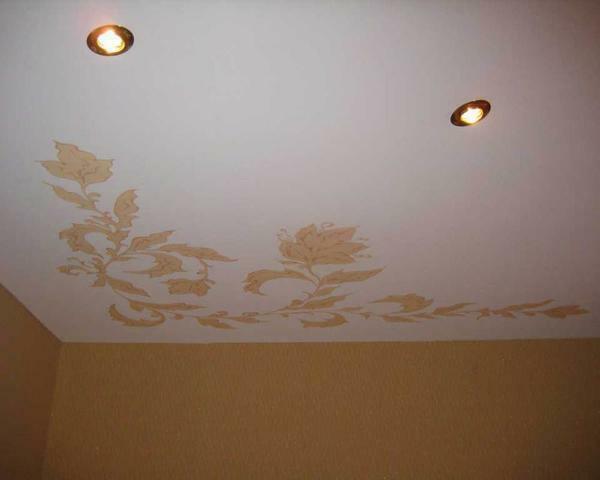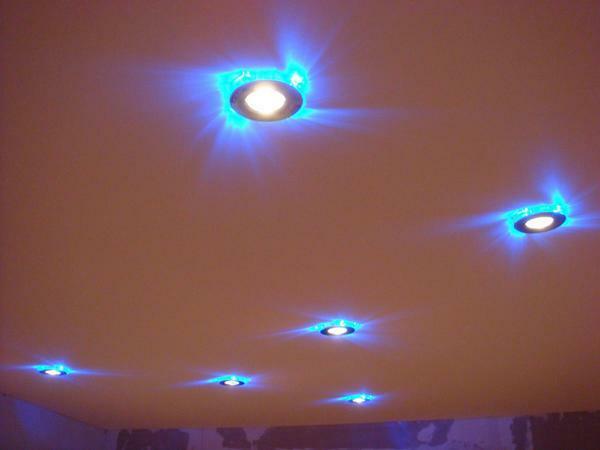
Whitewashing is the most traditional way to maintain the cleanliness and whiteness of the ceiling. For many centuries before us in Russia whitewashed huts a special mixture based on limestone. Lime - an environmentally friendly and completely harmless to human material. It has disinfecting properties, which is especially important for a bathroom, because high humidity is the most favorable condition for the appearance of fungus and the reproduction of bacteria. In addition, this type of coating is good for air and absorbs moisture.

Whitewash ceiling is very easy, in the bathroom it can be done in just a few minutes. As a result, with minimal effort and money, you get a fresh, beautiful ceiling covering, which, if necessary, can be updated very quickly.
Of course, this method has its drawbacks. First, the whitewashed ceiling needs to be refreshed from time to time, because, covered with dust, the lime quickly loses its original whiteness. Secondly, the lime coating is quite fragile, so if it is mechanically damaged or because of a poorly prepared working surface, it can peel off.

Preparation of
Before starting work, all surfaces and furniture are usually covered with plastic wrap, so that they do not get a whitening compound. When whitewashing the bathroom ceiling, there is no special need for this, since the lime is easily washed from the tile. However, if your bathroom is furniture and plumbing, made of expensive natural materials, it is better to be safe and cover it with polyethylene, and if possible - to take out of the room.

Next, you need to clean the ceiling from the previous whitewash layer. If the surface is fairly flat and light, then you only need to refresh the coating. To do this, it is sufficient to collect the accumulated dust with a brush or a vacuum cleaner.
If the ceiling has not been whitened for a long time, the previous coating darkened and began to exfoliate, then you will have to scrape everything down to the plaster. Do this as follows: using a spray or a wet sponge moisten the old whitewash, then collect the soaked lime with a spatula, and what remains is washed off with the same sponge. Do not apply too much force, otherwise there will be scratches and dents on the plaster, which will have to be closed.



When the ceiling dries, treat it with a primer. The composition for priming is selected depending on the material that we will use for whitewashing.
Material selection
Usually, lime, chalk or water-based paint is used for whitewashing the ceiling. We already spoke about the advantages of lime above. Characteristics of the chalk are almost identical. The advantages of whitewash with water-based paint are that it dries quickly, it is easy to clean and it falls well even on unprepared surfaces.
The paint for the ceiling in the bathroom was discussed in detail in another article.

Nevertheless, for whitewashing the ceiling in the bathroom, experts recommend using acrylic-based paint .This paint is excellent for use in rooms that are characterized by high humidity and temperature changes. Some manufacturers add components to acrylic paints to prevent the formation of mold and fungus. True, the ceiling coating with acrylic-based paint will cost you significantly more than the traditional whitewash with chalk or lime.

Thus, there are several options for whitewashing the ceiling, each of which has its advantages and disadvantages. Which one to choose is up to you.

Preparation of
If you decide to whitewash the ceiling with water-based or acrylic paint, then you will not need any preliminary preparation of the material. But with the preparation of the composition for whitewashing lime or chalk will have to tinker.
Preparation of calcareous whitewash. To prepare the solution, you will need:
- 10 liters of warm water, better filtered or stand-by;
- about 3 kg of slaked lime;
- 3-4 tbsp.edible salt of coarse grinding;
- 0.5 kg diluted in water color;
- 0.2 kg of aluminum alum, they are sold at the pharmacy.
Pour a little water into the deep container, then in turn fill all the components. Add the remaining water and mix thoroughly.

Preparation of chalk whitewash. You will need the following components:
- 5 liters of warm water, also filtered or stagnant;
- 3 kg of sifted chalk powder;
- 1 tbsp.joinery glue.
In a container with warm water, dissolve the carpentry glue, then pour the chalk powder into the resulting solution. Stir well.

In order for the chalk whitewash to look even brighter, before applying to the ceiling, a little bit of blue is added to it. The result is a white-white color with a barely noticeable bluish tint.
Required Tools and Accessories
In addition to the large capacity and the solution mixer, you will need a stepladder for whitewashing, or a stable stool if the ceilings are low, several brushes of different sizes, a paint roller or a vacuum cleaner with a nozzle.

Work is necessary in safety glasses, because the composition for whitening can severely damage the eyes. Put rubber gloves on your hands and hide your hair under the headdress. Protect the respiratory tract with a respirator or an ordinary medical mask.

Drawing
So, whitewash on the ceiling can be applied in three different ways:
- Using a paint brush. For the main job, you need a brush 20-25 cm wide, and hard-to-reach places and corners can be smeared with a brush. If the handle on the brush is not long enough, attach it to any light stick( for example, from a plastic squeegee).Work with the brush back and forth, moving it in one direction. After the first layer of whitewash dries, apply the following. The second layer must be applied perpendicular to the first.
- With roller. The paint roller works much more conveniently, as it distributes the paint over the surface in a thinner and even layer. If you prefer to work with a roller, then you will need a paint tray. Pour a little solution into it, dip the roller and begin to apply whitewash to the ceiling with wide movements. You can work in different directions, most importantly, make sure that the coating is uniform.
- Using a vacuum cleaner. You will need a nozzle-sprayer, which is also called a "spray gun".To do this, you need to select the operating mode, in which the length of the jet will be about a meter. Set the pressure to 3 or 4 atmospheres. Whitewash on the ceiling should be applied in circular motions, avoiding streaks. If necessary, a second coat can be applied.






To achieve a perfectly flat coating, you can combine the first and third methods. The first layer of whitewash apply with a paint brush, and the second - with a vacuum cleaner with a sprayer.
Tips
- To ensure that the coating is as uniform as possible, do not limit yourself to one layer of whitewash. The optimum number of layers - from 2 to 4. In this case, each subsequent layer should be applied on a completely dry surface.
- During whitening, follow the location of the lighting fixtures. The first and penultimate layers of the coating should be applied perpendicular to the light source, and the latter - in parallel. In this case, the marks from the roller or brush will not be noticeable.
- The coating will be durable and will not lose its original appearance for long, if you let it dry yourself without using heaters, fans, hair dryers, etc. Also it is necessary to protect a freshly beaten ceiling from hit of solar beams, the truth in a bathroom is not a problem.
- If the last time you bleached the ceiling with lime, then next time you can not use a different kind of coating, and vice versa. Only lime can be applied on top of the lime, and only chalk over the chalk. Otherwise, the ceiling will be covered with ugly stains and divorces.
- If you do not like the white-washed ceiling, you can add color pigments to the whitewash, achieving different shades. So, to give a greenish tint to the coating, chromium oxide can be used. To give a milky or beige shade, a burnt sienna or umber is usually used - natural natural pigments. Ocher helps to achieve the color of ivory, and the roan - pink and reddish shades.



